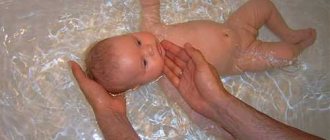Cardio for moms: running after childbirth
After the birth of a child, the question arises of returning to its former form.
Is it possible to run after giving birth? Certainly. With any training, a competent approach is important. It is necessary to take into account how the birth took place. After a natural birth and a cesarean section, the body recovers differently. If a girl has trained before, she will need less time to recover and start training.
It is important that the pelvic floor and deep abdominal muscles recover. The earliest time for their recovery to begin is the fifth week after birth. Only after this can you start running.
It is important to exercise with a heart rate monitor, and not just run until tired. You need to understand what heart rate you are running with. The average value should not exceed 150. For beginners, this is the optimal indicator to receive benefits and not overload your body.
What to pay attention to:
- The postpartum discharge should end.
- If you had a cesarean section, you can’t do it until the stitches heal. Otherwise they may separate.
- The body's own sensations.
- Before you start training, you need to visit a gynecologist. The doctor will give an accurate assessment of the body’s readiness - an ultrasound will show whether the uterus has recovered.
- Restore the pelvic floor muscles and deep abdominal muscles. They hold internal organs.
Before starting cardio after childbirth, it is important to pay attention to the following contraindications:
- Congenital heart diseases;
- Hypertension;
- Tachycardia;
- Arrhythmia;
- Chronic joint diseases;
- Flat feet;
- Anemia;
- Thrombophlebitis of the legs.
Running has a number of pros and cons.
- Joint injuries.
- Load on the spine and muscles, which are already weakened.
All this can be easily avoided with an adequate approach to training.
- Losing weight and increasing overall tone. It is important to combine exercise with proper and healthy nutrition. Otherwise there will be no effect.
- Improving blood circulation and metabolism helps reduce swelling and avoid acne. The skin becomes firmer and more elastic.
- Sound and healthy sleep.
- Prevention of depressive disorders.
- Milk may change taste or disappear. May occur in professional athletes due to the level of stress.
- The baby will begin to refuse on his own due to the smell of sweat. This is his mother's natural scent. On the contrary, T-shirts are provided for the child if he needs to go somewhere. Feeling the smell of his mother, he feels safe.
- 10 minutes of running is enough. This time is negligible. You need to exercise for at least 20-30 minutes at a good heart rate.
- It is better to train between 11 a.m. and 1 p.m., because the body is at its peak of activity. This myth has not been scientifically proven.
We need to remember simple truths:
- Selection of clothes and linen for classes. The girl should be comfortable. Freedom of movement is important, but the breasts must be supported.
- There is no need to chase marathon results. You can start by walking.
- During lactation, it is important to drink a lot during and after exercise to restore lost moisture.
Girls who have not trained before can start with walking. Then move on to running and more serious activities.
- Slow pace - jogging.
- Fast pace and short distance - sprint.
- Fartlek combines the previous types of running. It's about changing the pace.
It is better for any girl to start as if she is a beginner. Even if the level of her preparation before giving birth was impressive. This way she will gradually get into the rhythm without injuring herself. At the initial stage, fast walking and slow running are used. The load increases gradually.
It is important to pay attention to the body's signals. If you experience discomfort in the legs, chest or abdominal area, it is better to stop training for 2-3 days. A rise in temperature and weakness for more than an hour indicates that the body is not ready.
After 9 months of pregnancy and after the birth of the baby, the woman notices how much her figure has changed. Often, extra pounds are accompanied by several unpleasant symptoms: constantly swollen legs, pain in the knee joints, an aching back. Of course, every new mother wants to regain her former shape and beauty, and lose weight. From the outside, everything looks simple: go on a diet and exercise, but there is a very important point - breastfeeding, in which such methods of losing weight are simply contraindicated.
What should a young mother do who wants to become slim and beautiful after giving birth? What types of physical activity are allowed while breastfeeding (see also: can you get pregnant while breastfeeding?)? How do sports activities affect the lactation process? These problems and questions worry most women who have recently experienced the happiness of motherhood. Having received answers to them, they will be able to lose weight without harm to themselves and the baby.
Where should a nursing mother start?
This is a question we must answer in the second stage.
Immediately after the birth of your baby, create a proper balanced diet, taking into account the advice of your obstetrician-gynecologist and pediatrician: if you are breastfeeding, diet and exercise should not harm either you or the baby.
Some girls start training within a month after giving birth; others, especially if there was a difficult pregnancy and cesarean section, have to postpone the start of classes for another two or three.
The recovery period depends on chronic diseases, blood pressure, normal physical fitness (it’s foolish to think that if you weren’t particularly active before pregnancy, your muscles will quickly recover), and the tendency to bleed.
Start training with minimal loads
If you feel great, you can start when the postpartum discharge stops.
In the case of a cesarean section, you will have to avoid abdominal exercises, various crunches and planks for at least two more months.
It is also worth remembering that during childbirth there is a slight deformation of the pelvic bones, spine and back muscles.
This means that classes should be light and measured, so Pilates, proper breathing practices, some yoga asanas, and gymnastics for the back, arms and legs would be an ideal option for getting back in shape.
Many girls are interested in the question: when can they start exercising after giving birth with stitches?
The answer is clear - only after their removal and complete postoperative recovery.
This is interesting: Day 14. Professional tips for beginners
There is absolutely no need to provoke discrepancy, bleeding and possible prolapse of the uterus.
And in the case of a cesarean section, for example, you can start training the abdominal muscles approximately six months after the operation.
Give up an active sports lifestyle for a while in favor of proper nutrition and walks in the fresh air.
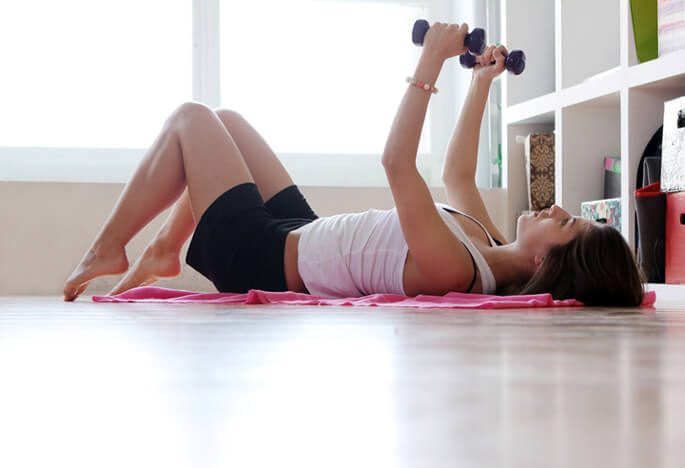
If you decide to exercise with dumbbells, their weight should not exceed a kilogram
When to start playing sports?
According to most experts, minor physical activity is allowed almost the very next day after the baby is born. Light exercises will not only do no harm, but will also help tone your abdominal muscles as quickly as possible. Of course, all this can only be said about healthy women whose birth took place without problems or complications.
In cases where a caesarean section was performed, ruptures occurred during childbirth, there is a risk of sutures coming apart and bleeding from physical exertion. It's better to wait a few months than to have health problems. In any case, before starting sports, it is advisable to consult with your gynecologist - only he will be able to competently assess the general condition of the mother and give her the right recommendations.
When can you exercise after childbirth with ruptures?
The recovery and healing process is individual for everyone, but if stitches were placed after childbirth, only a doctor can guide you, so it is especially important not to miss a routine examination by a gynecologist.
It may take up to six months for the body to fully strengthen and return to shape, otherwise there is a danger of the stitches coming apart.
The only exception in this case may be Kegel exercises - they strengthen the muscles of the perineum and vagina, help overcome the problem of urinary incontinence and normalize blood circulation in the pelvis.
In a normal birth, they can be performed the very next day.
For ruptures, careful training begins 1-1.5 months after suturing, sometimes earlier.
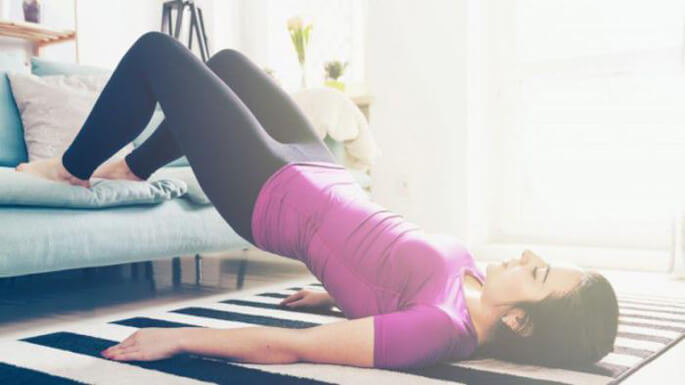
With your doctor's permission, practice Kegel exercises
It is important to monitor your well-being and the absence of discomfort.
And we repeat again - every woman’s body is individual, do not be shy and do not be lazy to ask the doctor if it is possible.
The first physical activity, when it is already possible for a nursing mother to engage in gentle sports after childbirth, is recommended by the famous doctor Evgeniy Komarovsky to start with the most basic:
- Walk and walk with children more often
- Standing more than sitting means you'll burn twice as many calories.
- Find a friend to go shopping and play sports together, while talking you will not noticeably increase the distances traveled
- Praise yourself for regularity and fidelity to training
- Take them seriously and don’t look for excuses from the series: “I’m a mother, I have a child, I don’t have time,” because 99.99% of success is your desire and desire to return your body to its former attractiveness
This is interesting: How much does the former “Policeman from Rublyovka” earn now? All sources of income of Alexander Petrov
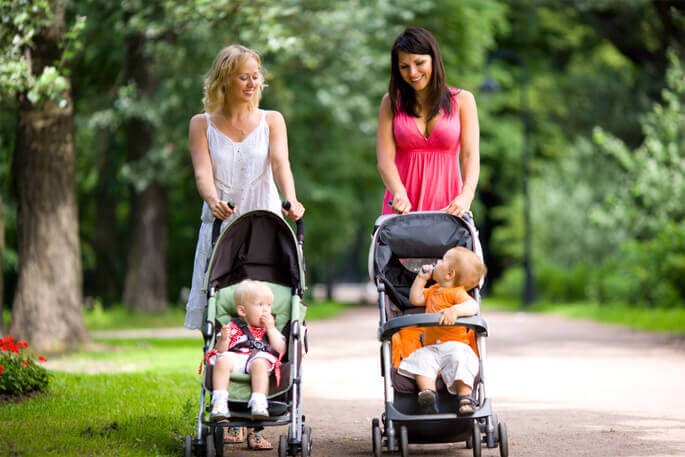
Take more walks in the fresh air
How to exercise correctly?
The most important principle is that physical exercise should bring pleasure and joy to the nursing mother.
When playing sports during the breastfeeding period, you should adhere to several rules and principles:
- You should not pay much attention to strength sports, because after childbirth it is more important to get rid of excess weight, achieve muscle tone and restore body elasticity, and not to gain muscle mass;
- It’s better to start getting your body in shape with exercises on the abdominal muscles, since during pregnancy they become flabby and stretched, besides, this will help reduce the load on the lower back, and the uterus will be able to quickly contract and return to its previous size;
- after a couple of weeks of training, you can increase the load on the abdominal muscles, as well as add bends and turns of the torso, squats;
- physical activity promotes the production of lactic acid by the muscles, and when it gets into the milk, it changes its taste properties not for the better, which is why the baby may completely refuse such food. To avoid such a situation, experts recommend that young mothers engage in sports immediately after breastfeeding or 1.5 hours before;
- During active physical activity, the body loses a lot of fluid, the deficiency of which is dangerous because the production of breast milk can be greatly reduced, so you should definitely pay attention to your drinking regime, you must consume a sufficient amount of clean water during training, drinking in small sips no more than 100 ml per day. once.
Recommended types of fitness after childbirth
Immediately after childbirth, preference should be given to those types of sports activities that do not involve heavy physical exertion. It could be:
- Walking is a very simple and accessible form of physical activity for a nursing woman with a newborn baby. Walking with a stroller will bring a lot of positive emotions to both, in addition, walking perfectly trains the cardiovascular system and helps speed up metabolism, and therefore burns fatty tissue formed during the months of pregnancy;
- yoga - these classes differ from other types of fitness in that all movements are performed measuredly and smoothly, during training, complete relaxation occurs, breathing improves, muscles become toned, and mood improves. It is not necessary to do yoga in a sports club; it is quite possible to perform asanas at home;
- aerobics or shaping - these sports are more suitable for active women; you can go to a fitness club for classes or do them at home yourself, because it’s very simple - you just need a mat, a few small dumbbells, catchy music and a positive attitude;
- swimming - this type of physical activity helps strengthen muscles and relax the spine, which in the last months of pregnancy and after childbirth experiences a lot of stress, because the mother has to lift both the child and the heavy stroller, and breastfeed the baby. Swimming in the pool also calms the nervous system;
- Water aerobics is an excellent form of fitness in the pool, allowing you to quickly get your body in shape. You can start exercising as early as one or two months after giving birth, because water is a wonderful simulator, thanks to which the muscles work with increased load, but the tension is not felt - nursing mothers can swim in the pool without any restrictions.
You can also add hula hoop classes to your training program to regain a thin waist. Exercises on a fitball are also suitable - a large ball that will help maintain muscle tone.
What should you not do after childbirth?
There are some types of physical activity that nursing mothers are not recommended to do for the first time after childbirth. First of all, these include:
Any young mother, even if she has several children and a lot of housework, can always find 15-30 minutes a day for herself if she wants. Sports during breastfeeding will not only have a positive effect on a woman’s figure, but will help her find a good mood and vigor, and the mother’s positive emotions will certainly be passed on to her baby.
Weight gain during pregnancy is considered an absolutely natural phenomenon. It is equally natural for women to want to quickly lose excess weight when pregnancy is over. And then natural questions arise: how long should you wait after giving birth so that running doesn’t cause harm, and is it necessary to wait at all? How will running affect lactation? In this article we will consider both cases: jogging in the postpartum period for nursing mothers and for mothers who are not breastfeeding or have completed breastfeeding.

General recommendations
If after reading the article you have no doubt whether you can play sports while breastfeeding, remember the small rules that need to be followed during training.
- Alternate exercises where the body tenses with relaxation exercises.
- Start with short workouts, gradually increasing the time and intensity of your workouts.
- Drink water after exercising.
- Don't exercise for more than an hour a day.
- Work out in comfortable clothes. Don't ignore shoes if the exercise requires it.
- Buy quality supportive underwear to avoid injury to your breasts.
- If you feel weak and tired after playing sports, adjust your exercises by reducing the load.
As you can see, playing sports while breastfeeding is not only possible, but also necessary. The main thing, as with everything else, is to know when to stop and listen to the body.
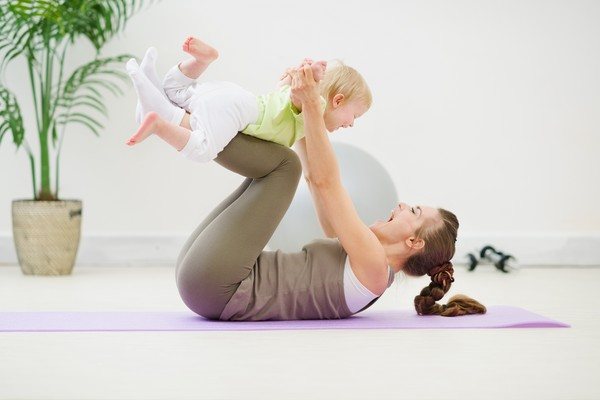
- Related Posts
- Strepsils for nursing mothers: instructions for use
- How is Dopegit used during breastfeeding, dosage and side effects
- Does Smecta harm a nursing mother?
« Previous entry
Contraindications for running
Doctors identify a number of contraindications to running that are common to all people. Among them:
- arthritis and other diseases of the knee or hip joints;
- flat feet or a tendency to roll the feet inward;
- circulatory failure;
- mitral stenosis;
- severe heart rhythm disturbances;
- Congenital heart defect;
- thrombophlebitis of the lower extremities;

And, most importantly for the purposes of this article, intense running is extremely undesirable:
- in the first 2-3 months after childbirth, if the woman had already practiced jogging before pregnancy;
- in the first 6 months after childbirth, if the woman led a sedentary lifestyle;
- after cesarean section until the scar is completely healed;
- nursing mothers.
In the latter, strong physical activity can lead to a decrease in the amount of milk or its complete disappearance. Also, in most cases, milk acquires an unpleasant taste, as a result of which the child may refuse breastfeeding.
When and with what exercises should I start after childbirth?
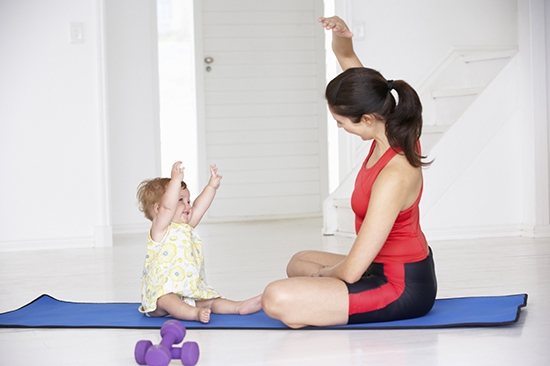
You should start with small, habitual efforts, increasing their intensity: walk more and move in general. Walking with your child is an excellent reason to prepare yourself for more complex physical activity. At home, you can perform simple exercises every day that will help restore the shape and overall tone of your muscle mass. For training you will need only 5 minutes of your free time.
There is no clear answer to the question of when you can exercise after childbirth. According to average statistical indications, after childbirth without complications, you can begin active exercises after about 1.5 months, after a caesarean section, difficult birth with injuries or complications - after 2 months. The attending gynecologist who observed you during the entire period of pregnancy will tell you a more accurate date.
Jogging for non-breastfeeding mothers: when to start and how much to run
If the required 2-3 months after childbirth are already behind you, and the woman does not plan to breastfeed or has completed breastfeeding, you can safely start daily jogging.
Biorhythmology considers the optimal time for physical activity to be from 11:00 to 13:00, when the body is best tuned to developing endurance. Although deprived of this advantage, evening jogging still has one advantage.
If a woman has previously been far from sports and is starting to run for the first time in her life, she will need a few easy-to-follow tips:
Is it possible to run after giving birth?
Home » Pregnancy and childbirth » Is it possible to run after giving birth?

Everything for health!
Running is incredibly good for your health. Imagine that in just half an hour of intense running you can burn up to 500 kcal, warm up and give a load to all muscle groups, especially the gluteal, front and back muscles of the thighs, get the blood actively circulating and deal the hated cellulite a crushing blow! By running regularly, you reduce the production of stress hormones and begin to perceive everything that happens in your life more positively and calmly. Many women claim that it was jogging, which they included in their daily schedule, that helped them overcome the depression associated with the inability to lead their previous active life during maternity leave. There is another therapeutic effect: fresh air magically removes irritation and resentment from your head, replacing them with good thoughts about the imminent improvement of your life. After a run, you are already a different person!
Who is contraindicated for running ?
So, you've made the decision to run, and that's commendable. But first you need to make sure that you have no contraindications to running: you are not worried about arthritis or other diseases of the hip and knee joints.
There is no obesity or cardiovascular disorders, varicose veins or phlebitis of superficial veins, or spinal problems. If you suspect any of these diseases, doctors do not recommend running. Women with flat feet and a tendency to roll their feet inward should approach running with caution. Women who have just given birth should not start running - at least 3-4 months must pass from the date of birth. Breastfeeding women should not run either - the milk may “leave” or acquire an unpleasant taste, which is why the baby will refuse valuable breastfeeding.
When and how much?
If you have already finished feeding and you have no contraindications for running, besides, you urgently need to change your mood - run for a beautiful figure and a good mood! Young mothers are concerned about the question of what time is best to run: morning, evening or afternoon? It all depends on your routine and that of your child. If you are a morning person and feel a surge of energy in the morning, you should get up half an hour earlier and go to the nearest park or to the still deserted streets of the city. Morning jogging is also great because it gives you the opportunity to unload your senses. In the early hours it is not as noisy as on a busy day, birds are singing, leaves are rustling, the cool air is invigorating and there is an opportunity to listen to yourself. Great start to the day!
In addition, practice shows that after a morning jog, all household chores are solved much easier and faster. The body still continues to act according to the “accelerated program” by inertia.
It would be a good idea to sleep in the afternoon with your baby - sleep will restore strength and give you the opportunity to live the second half of the day just as energetically. Running at the start of a new day is not a bad start at all!
Those who have the opportunity to leave their child exclusively during the day can also run after childbirth . According to biorhythmology, the most suitable time for physical activity is from 11.00 to 13.00. It is at this time that the human body adjusts to endurance training. In addition, before the evening you will have time to relax and then fall asleep normally at your usual time.
What to do when your baby is always with you? It turns out there is a way out! Run around the stroller with your sleeping baby. Believe that they will not consider you crazy, but will only admire your love of life and ability to find the positive in everything. Evening jogging is no worse than morning and afternoon jogging. Moreover, they have their own advantages. It is known that the evening hours are considered the most dangerous for your figure: sitting in front of the TV, you just want to eat something delicious! But if you replace unnecessary snacks with a 30-minute run, then drink a glass of water and take a shower with relaxing products, you will feel blissful! Brew some herbal tea, read an interesting book and go to bed!
Load dosing.
In order for running not to be a cruel chore, but to actually turn into pleasure, you need to know some simple rules.
- The main mistake of all novice runners is the desire to run the maximum distance in the minimum period of time the first time. After experiencing unpleasant emotions, you decide that running after childbirth is not for you, and you are forever disappointed. You don't want to set your personal best! You should always start with a walk, then gradually switch to jogging, and only towards the end of the workout can you safely increase the speed. Optimal time for a beginner: at least 20 minutes and no more than 40 minutes in the first few runs.
- To avoid giving up running after the first week of training, set realistic goals for yourself. It is clear that you will be able to lose weight after giving birth gradually, and not immediately, and weighing yourself after every run simply does not make sense. In addition, be prepared for the fact that excess fat will be the first to disappear from those places where it least bothers you: first you will notice how your face and chest have lost weight, and only then, subject to continued training, your hips and buttocks will tighten.
- Don't overwork yourself, but don't be lazy either. Excuses from the series: “Today I need to run for half an hour more. so as not to run tomorrow” are not serious. Overloading the body is very harmful, it’s better to tell yourself that tomorrow is your day off, and go for a run today with special pleasure.
- Don't forget about fuel. Food must be proper, providing the body with everything necessary for a normal life. Nutritionists often use this psychological technique to support their patients. Imagine that you are a car, and think about what kind of car you would like to be? Of course, a fast and bright sports car, and not a rattling wreck. If you fill a luxurious and fast car with cheap and bad gasoline, you most likely will not be able to move it. The same goes for the body: for effective training, it is important to eat right. Forget about protein diets: for those who decide to make running after childbirth a part of their life, carbohydrates are necessary. They are the same high-quality fuel. Porridge, whole grain bread and vegetables will perfectly charge your body! Moreover, contrary to popular belief, you must eat before jogging. Half an hour to an hour before you put on your sneakers, be sure to eat a small portion of porridge so that your body concentrates not on digesting food, but on the jogging route.
- After training, you should not eat for at least 1.5 hours. But you can drink as much as you like!
Well-being assessment
To assess your own well-being, use a simple test. Try talking to yourself (or on the phone) while running. If conversation is easy for you, then the workload is moderate. If you have difficulty pronouncing words and pause, you are in medium speed mode. But when it is not possible to utter even one phrase, you have developed a peak speed, and your heart is now starting to work for endurance! Peak exercise is incredibly beneficial for cardiovascular training, but the duration of this peak effort should be increased gradually.
Running clothes
Today, many sports stores offer running clothing.
Pay special attention to clothes and shoes: they are the ones who guarantee that you get what you wanted from your run.
You most likely don’t need T-shirts and trousers for professional marathon runners, but it’s worth taking a closer look at clothes for amateurs. T-shirts, trousers and sweaters should provide thermoregulation and absorb sweat well. The only exception is special shorts for weight loss. They are designed taking into account the fact that during running the body removes more water through the pores and you visually lose volume. The thing is extremely useful! Increased attention to shoes. Running shoes are very lightweight, they are made of nylon, which provides ventilation, their sole is shock-resistant and ensures the correct position of the foot while running. When choosing sneakers, explain to the seller what exactly you want from the shoes: will you run along forest paths or on the sidewalk, will a sudden drizzling rain cancel your workout, or are you going to run exclusively in dry weather. Don’t forget about aesthetics: you want to wear modern bright, stylish and lightweight sneakers more often. Isn't this a reason for an extra run?
Alternative to running
For those who, for one reason or another, cannot run, walking remains the most natural way to keep fit. When walking, joints and ligaments are not injured, you do not need to recover your breath for a long time, and you can simply enjoy the walk without focusing on time and speed. You need to walk for at least one hour, periodically changing the pace from fast walking with wide steps to small steps of medium speed ( race walking ). For walks with a stroller, this is an ideal option: both the baby walks in the fresh air and the mother spends quality time. When walking, the body should be in a strictly fixed position: the shoulder blades are brought together, the neck does not lean forward, the buttocks and abs are retracted. This is not an easy task, but it is what ensures the correct position of the spine. Imagine that there is a straight axis in the middle of your body that prevents it from deviating either to the right or to the left. Meanwhile, the hands are relaxed. Don’t forget to complicate the route: climb hills, stairs, overcome obstacles more actively - this will add variety and increase the load. Whatever you decide to do, running or walking , the most important thing you have already done is to prepare yourself for the changes. And this will definitely be rewarded!
Running for nursing mothers
The reason that nursing mothers are placed in a separate category is the effect of intense physical activity on lactation and, in general, on the body of a woman who has recently given birth. Excessive exercise can lead to:
- the appearance of an unpleasant taste in milk (the reason is the abundant secretion of lactic acid formed in the muscles);
- decrease in milk volume;
- lactostasis;
- hypertonicity of the uterus;
- uterine bleeding.

Here are the main conditions:
- The duration of the first workouts should be 10 minutes, and they should take place at a minimum pace (race walking is also suitable). Subsequently, the jogging time can be increased, but half an hour is considered the maximum for a nursing mother.
- During training, you need to drink a lot.
- You will have to refuse a cold shower after a run - only warm showers are allowed.
- You should feed your baby right before training. After a run, you need to wait at least an hour and a half before the next feeding.
- Careful selection of clothing is required. Sweatpants should not squeeze your stomach, and your bra should not squeeze your chest.
A common situation is when a nursing mother, inspired by the first progress in losing weight, sharply increases the load. This naturally leads to a deterioration in lactation - fortunately, temporary. In this case you should:
- immediately reduce the intensity of your runs;
- introduce into the diet foods that enhance lactation (milk, cottage cheese, hard cheese, nuts; decoctions of dill, fennel, cumin or anise seeds);
- increase the amount of fluid you drink.

Also, some nursing mothers who do not want to give up sports make a reserve supply of expressed milk. Once frozen, it can be stored without changing its properties for about two months. If lactation weakens, the mother can use stored milk while she restores milk production.
Other sports for moms
When there is no desire or opportunity to run, this sport can be successfully replaced with the following activities, which are allowed even for nursing mothers:
- Swimming. Quickly burns fat, strengthens ligaments, and restores muscles. However, you can visit the pool only 3 months after giving birth.
- Walking. It is considered the most natural and safe physical activity for humans. A huge plus is that there is no need to look for someone to leave the child with, since you can go for walks with him.
- Yoga for beginners. Normalizes blood pressure, prevents the occurrence of heart disease, improves sleep. You can start classes 40 days after birth.
- Pilates. Develops agility, endurance, strength and flexibility, corrects posture. In most cases, you can start exercising 4 months after giving birth.
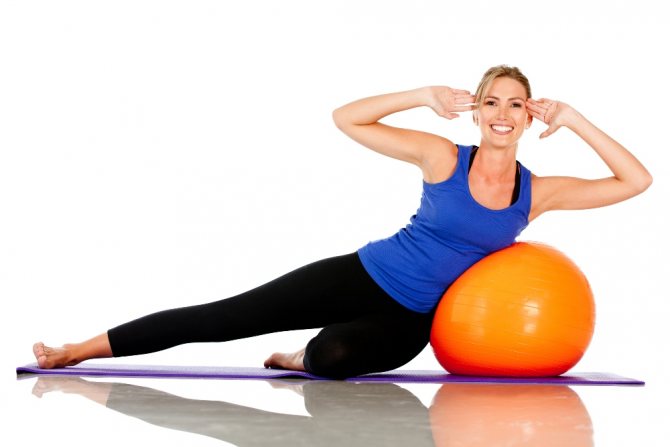
The comprehensive effect of running on the body is to strengthen the cardiovascular, immune and musculoskeletal systems, as well as normalize the endocrine system. A woman who has not previously practiced jogging can take up running 6 months after giving birth. If the mother was involved in sports before pregnancy, this period can be reduced to 2-3 months. Beginners should start with 20-minute workouts, gradually increasing their duration. Nursing mothers, in order to avoid lactation disorders, must be content with 10-minute runs, eventually increasing their duration to the maximum allowed 30 minutes.
There are a lot of myths and ambiguous information on this issue on the Internet, including some that are not substantiated. To find out, we found research and learned about the experiences of running moms.
We remind you that Nogibogi is now on Telegram. There we share all the most interesting and useful things that we come across on the Internet on the topic of running and healthy lifestyle. It's convenient, join us!
The birth of a child is a long-awaited moment in a woman’s life. With a storm of emotions and love, a new stage begins, and the usual things fade into the background. Among them are sports, for which there is often simply not enough time.
But many of us still think about physical activity and wonder when we can resume exercise (in our case, running) after childbirth, and whether it is compatible with breastfeeding.
Sports that are not suitable for a nursing mother
Not all sports activities may be beneficial for a breastfeeding woman. During lactation it is better to refrain from the following sports:
- Aerobics and step. These sports and lactation do not go together because they are based on impact exercises. There are also a lot of jumps performed. During training, the mother's body can lose too much energy. There is also a risk of chest injury.
- All types of struggle. There is a risk of chest injury during such activities.
- Strength sports. Breastfeeding mothers should not lift barbells or heavy dumbbells, as such exercise is extremely energy-intensive and can lead to a decrease in milk supply.
- Athletics. There are different opinions about the combination of lactation and this sport. Many doctors believe that running causes the chest to fluctuate a lot, which can lead to injury, and therefore are against such activities. Others suggest that with the right underwear, a woman can run for about 30 minutes every day.
When can I return to running after giving birth?
Before you go for your first run, you need to visit a gynecologist. Each woman is individual, and the state of the body after childbirth varies. Some are ready to run as soon as they are discharged from the maternity hospital, while others will not be able to even after six months.
Doctors set this deadline due to the fact that the woman should have run out of postpartum discharge. This is also the minimum period that the body needs to recover and not be in a tired and exhausted state.
Women who have given birth via cesarean section should abstain from physical activity for at least three months. You can resume training only with your doctor's permission.
You need to start easily and gradually; you shouldn’t set serious goals right away. Just enjoy every run, even if it's the slowest pace you've ever run.
Also do stretching and gradually include exercises to strengthen the abdominal and back muscles, which are in a weakened state after childbirth. If possible, it would be useful to take a massage course.
What discomfort can occur when running after childbirth?
It seems as if you did not run a kilometer at the slowest pace, but did good tempo work to accelerate. What to do? Start very slowly and feel free to slow down to a walk to restore your heart rate and breathing.
The discomfort is due to the fact that during pregnancy there was constant pressure from the fetus on the back, and the muscles gradually relaxed under the influence of relaxin.
After childbirth, these muscles often weaken, leading to pelvic organ prolapse and, as a result, urinary incontinence.
To return the pelvic floor muscles to their previous state, so-called Kegel exercises are recommended. This is a set of movements that result in alternate contraction and relaxation of the pelvic floor muscles. After regularly performing such exercises, urine output due to incontinence decreases.
During pregnancy, a woman's pelvis changes to make childbirth easier. The pelvic bones are moving apart. The most dramatic change affects the pubic symphysis. The blood flow to it increases, the ligaments and soft tissues swell, and thus a discrepancy of several millimeters is formed.
Excessive development of the pubic symphysis leads to changes in the osteoarticular system of the body. This takes on the appearance of a pathology, and the pelvis after childbirth brings discomfort and pain.
In such a situation, consultation with a doctor and treatment are required. To prevent discrepancies, a diet enriched with microelements, light physical activity, and a course of physiotherapeutic procedures are recommended. But intense loads will still be prohibited for the first time.
Pain in the joints after childbirth occurs due to the heavy load on them during pregnancy, or due to a lack of calcium in the body. It could also simply be the body’s recovery process, which occurs individually for each woman. In addition, a woman with a baby spends a lot of time on her feet, which also leads to fatigue and painful sensations in the joints.
Standard recommendations: take vitamins, spend time stretching and get as much rest as possible. If you have pain and fatigue, it is better to postpone training.
During pregnancy, hormonal levels change greatly, and it takes some time to restore them. To make the process faster and easier, it is recommended to eat well, get enough vitamin D, engage in light physical activity, and improve your emotional background.
Establishing hormonal levels directly affects the condition of the baby and the woman’s lactation. If running brings you pleasure and there are no contraindications to it, then this is a good way to help the body during this period.
Exercise sets
Gymnastics with a baby
Source https://club.osinka.ru/viewtopic.php?printertopic=1&t=29877&start=0&postdays=0&postorder=asc&vote=viewresult&sid=972499a141d4d80de459e366bd564fcc
Lie comfortably on a plane - the floor, bed, sofa and place a pillow under your head.
- Lying on a plane, knees together, raise your legs perpendicular to the floor and bend your knees. Then let someone put the child on your feet - on your shins - with his head towards you (then you will deal with this yourself). You take your hands by the wrists, your heels apart - spreading the child's legs - so that he does not move out. Movements - towards yourself and away from yourself, with your arms outstretched as much as possible - and pulling your knees towards you as much as possible with the child lying on them. At the same time, the tummy is massaged and the baby receives passive gymnastics of all muscles, and the mother trains... everything! Yes, and don't forget to smile.
- The pose is the same. Movements to the side, tilting the legs with the child to the sides as much as possible.
- Movements like the letter “O” left and right.
- Raise the child's legs as high as possible and lower them as low as possible.
- Standing, with outstretched arms, we SLOWLY lift the child up above his head and SLOWLY lower him. We hold the child under the arms and chest.
- Standing also, we slowly raise and slowly lower, sitting down with the child, touching his legs to the floor and, as if pushing off from the floor, SLOWLY take off above his head. It’s better to do all this in a diaper. And do standing ones for dads.
We do all exercises from 5 to 25 maximum. Don't chase quantity. All of them should bring pleasure to both you and the child. abs may hurt a lot . I’ll cite from there only a few exercises that complement the previous complex.
source https://www.solnet.ee/parents/p6_15.html
- During pregnancy, your spine received constant heavy loads. During childbirth, the possibility of vertebral displacement cannot be ruled out. The following exercise will help you restore flexibility and relieve back pain. The starting position of the baby is lying on its back on the floor. Lay down a rug first to keep your baby warm. Get on all fours over your baby. Perform the cat with the spine arched and moving forward. The proximity of your body to the baby's body will give him fabulous pleasure. This exercise perfectly stimulates lactation.
- Slim waist? Nothing could be simpler. Place your baby on your shoulder, place your feet hip-width apart, and tilt your body in the opposite direction. After 10-15 repetitions, perform the exercise in the other direction.
- Lie on your back, bend your knees and place them on the floor. Place your baby's tummy on your stomach. Place your hands behind your head. Lift your head and shoulders off the floor while exhaling. The lower back is always pressed to the floor.
- Massage for the buttocks. Sit on the floor, straighten your legs. Place the baby facing you on your thighs. Lifting your buttocks one by one, move forward 5-6 meters and back. You can pretend to be a train.
Back to the “Useful information” selection
Is it possible for a nursing mother to run, and does training affect lactation?
There are many myths about how running affects the amount of milk, its composition and taste. We found out what scientists and breastfeeding experts think about this (links to studies are at the end of the article).
Studies have shown that moderate exercise has no effect on the amount or composition of milk.

A common sight in Central Park (New York): young mothers actively use jogging strollers to be with their baby even during training. Photo: flickr.com/photos/yourdon
According to the results of one study, after intense exercise, milk has a short-term decrease in IgA (immunoglobulins) and there is a certain effect of lactic acid, but there are no differences in immunological factors.
A 1997 study found that during intense exercise, the levels of microorganisms in breast milk decreased within a short time (10–30 minutes), but within an hour these levels returned to normal.
The study also found that IgA levels increased after feeding, regardless of whether the mother had exercised.
In 2003, Loveladdy and others, examining immunological factors (IgA, lactoferrin, lysozyme) in the breast milk of exercised and sedentary mothers, found no differences between them.
A study was conducted regarding the taste of milk and the effect of lactic acid on it, which showed no noticeable increase in lactic acid after moderate exercise.
Lactic acid levels in breast milk increased slightly 90 minutes after intense exercise when exercise was performed at maximum effort. However, this had no effect on the quality or difference in taste of the breast milk. Most studies have shown no difference in a baby's breast milk intake, even after intense exercise.
If the baby still refuses milk and behaves restlessly, this is most likely due to salty sweat getting into the milk ducts and onto the very surface of the breast. Therefore, if it is not possible to shower immediately after training, it is important to at least wipe your breasts and express a few drops of milk.
We can conclude that physical activity does not in any way affect the quantity and taste of milk. The main factors in its quantity and quality are the frequency of breastfeeding, high-quality nutritious food and control of water balance.
If you start training, don't forget to drink more fluids. Train only for pleasure and with moderate load.
To support the breasts while running, a nursing mother needs to choose the right sportswear so that the breasts are securely fixed. There are sports models adapted for feeding if you train with your child (for example, use a jogging stroller).
The main obstacle to exercise may be health conditions after childbirth, ruptures, poor healing after caesarean section, weak joints due to loss of micronutrients during pregnancy, fatigue and poor sleep. Therefore, always consult your doctor and approach each workout with responsibility and the understanding that the health of you and your baby always comes first.
Personal experience of mothers
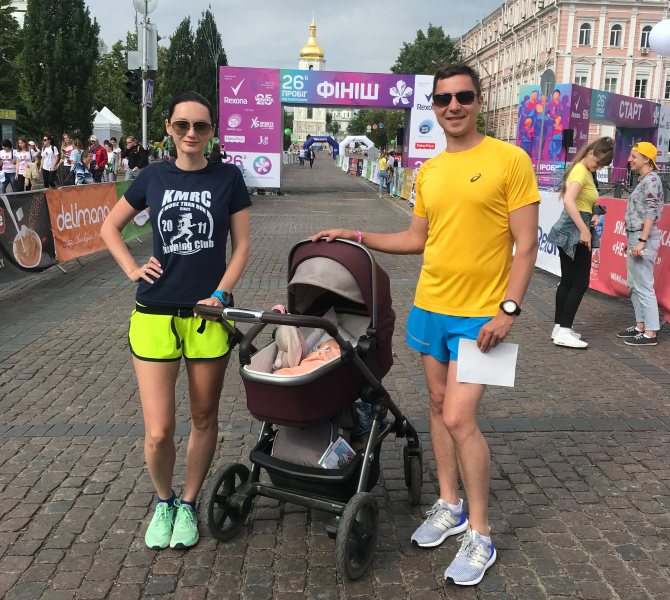
I resumed training 1.5 months after giving birth. I ran until the 37th week of pregnancy, but despite this, the first workout was quite difficult. I ran 6 km at once, but at a very slow pace.
I try to run three times a week. Thank you for having someone to look after the baby. After a month of regular jogging, I connected a training plan that was written for beginners from the KMRC club. There is definitely progress, but we still need to get into shape.
Training has had only a positive effect on my breastfeeding. I don’t know if it’s a coincidence or because of the training, but my lactation has improved, although before that I had some problems.
I try to remember to drink more, but this is also not an indicator, as it turns out from experience. Milk always comes, regardless of whether there was a workout or not, and sometimes even more than I expected.
My daughter refused to eat only once, but a quick shower fixed everything. Perhaps the exercise was more intense and the day was hotter that day, which led to more sweating. Although there were days when she ate immediately after training, and I did not have time to immediately go to the shower. Once I had to feed after the competition: all I did was wipe my breasts with a damp cloth. Running is my place of relaxation, which I treasure very much.

Training began as soon as the child was one month old. I felt great, considering the constant lack of sleep, but my energy was almost zero.
Physical activity did not affect lactation, there was even more milk.
For now this is one training session a week (the baby is not yet two months old), but I want at least 2-3. Progress is changeable: when there is more strength, when there is less, as always, we are talking about not very good sleep for the mother.
The child never refused milk, but on the contrary, after a short separation he ate even more and with pleasure.

I started running when my son was four months old, from one to five kilometers. It was a little hard, but with each workout it became easier.
The milk did not decrease after running, my son feels good and did not refuse milk. I train 2-3 times a week, running becomes easier and the pace increases.
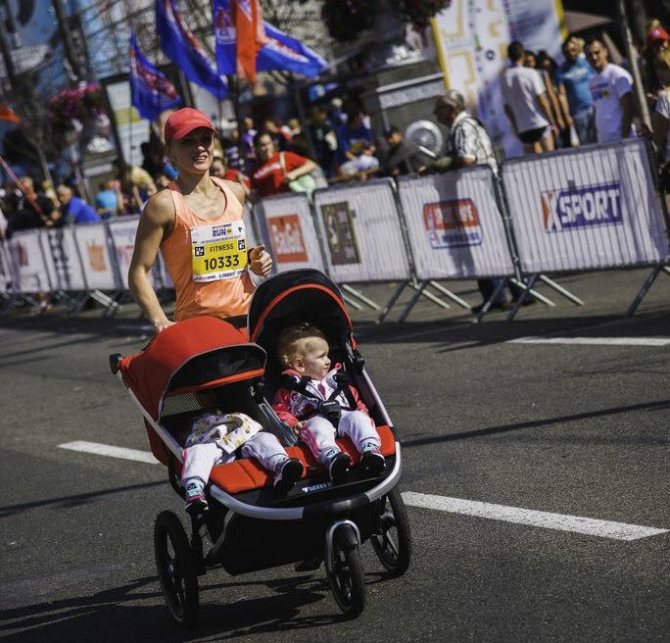
After a normal birth, I resumed training a month later. When I gave birth by cesarean section, I returned to running no earlier than three months and after a mandatory consultation with a doctor.
It is best to start training under the guidance of a trainer who specializes in postpartum recovery.
The first run was at a very slow pace and only 2 kilometers. After the cesarean section, my lower abdomen was bothering me.
I train 3 times a week to make progress.
Physical activity did not negatively affect milk. On the contrary, during training, blood circulation increases and more milk is produced. When I was feeding twins, there was not enough milk and I had to feed with formula (but this is not due to the fact that I resumed training). The kids never refused to eat after training.
You should definitely choose good sportswear to support your breasts so that there is no unnecessary fluctuation.
The struggle with excess weight is a familiar situation for many women after childbirth. Someone is trying to lose weight with a diet, some mothers manage to go to the gym. And there is a certain category of women who want to lose weight, combining business with pleasure, and choosing daily jogging in the fresh air. But there are a number of questions that concern young mothers who want to lose weight through running - how safe is running while breastfeeding and how does it affect lactation?
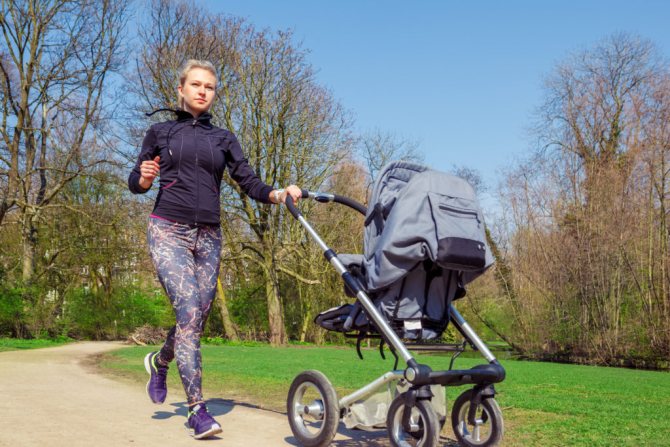
Important Rules
Basic principles of harmless, effective and safe training during breastfeeding:
- If you are worried that the lactic acid produced by the muscles may get into the milk and affect its taste, then it is better to start training immediately after feeding, in this case the substance will have time to be processed and disintegrate. In any case, classes should end no later than an hour and a half before the next feeding.
- If you are a beginner, then first choose the simplest exercises and perform the minimum number of repetitions. Gradually increase the number of approaches and pace. Then try moving on to more complex elements.
- Don't overwork yourself, as it can cause you to lose milk. If you feel tired, rest and recuperate.
- Avoid exercises that involve sudden movements, such as jerking and jumping. Also give up power elements.
- Choose comfortable clothes. It is advisable to wear a special supportive sports bra, a tank top and shorts (or tights and a sweatshirt if the room is cool).
- Avoid dehydration, which is especially dangerous for breastfeeding mothers because milk production requires fluid. To protect yourself, drink water (regular purified or mineral) during and after training.
- Monitor your condition carefully. If you feel weak or dizzy, stop exercising immediately.
- Don't forget to eat right. The diet must certainly include meat, fish, cereals, cereals, fruits, berries, vegetables, vegetable oils, and dairy products.
- It is advisable to exercise regularly, namely at least two to three times a week.
- If your child does not allow you to train, then choose special exercises for mothers and babies that involve doing them in tandem, that is, with the baby in your arms.
- Remember that activities should bring joy. After training, you should feel a slight pleasant fatigue and tension in the muscles. If you feel pain and exhaustion, then you should reduce the load.
- Pay special attention to problem areas. And the most problematic of them for many mothers is the stomach. But don’t forget to load other parts of your body to make your workouts as beneficial and effective as possible. But you shouldn’t strain your chest just yet.
Let the training be useful and effective and not affect lactation in any way.
What are the benefits of running?
First of all, a short run is an active fight against calories. A moderate thirty-minute run burns about 500 calories. In addition, running has a positive effect on the body in the following ways:
- Distribution of the load across all muscle groups.
- Normalization of blood circulation.
- Active physical activity accelerates the production of endorphins, while preventing the formation of the hormone cortisol, which is responsible for stress and anxiety.
- Restoring sleep patterns.
- Increased performance.
- Boosting immunity.
- Increase in the volume of the heart chambers.
- Stabilization of blood pressure.
- Strengthening bone tissue.
After the birth of a child, a certain part of women have a catastrophic lack of time for themselves and getting their bodies in order. Jogging allows them, at least for a short time, to escape from the usual hustle and bustle, thereby improving their mood and getting rid of stress.
Contraindications for jogging
As you know, pregnancy and lactation are not diseases. Therefore, contraindications for running for nursing women include all those that apply to the average person:
And you can add to this list periods when intense exercise and running are undesirable:
- The period before the child is three months old, and only if the mother actively ran before pregnancy.
- The first six months after giving birth, if the woman has not been friends with sports before.
- If the baby was born by caesarean section, then you must wait until the suture is completely healed.
- Breastfeeding period.
It is believed that due to running, milk production deteriorates, or it may disappear completely. It is also possible that the milk will change in taste and the baby will not like, which is why babies even refuse to breastfeed.
Running for women who do not breastfeed: when to start, how much and how to run
We are talking about mothers who have already endured the required months after childbirth, have completed breastfeeding, or no longer want/cannot feed the child. Then you can start training on any convenient day.
During the day, it is most beneficial to start running between 11 a.m. and 1 p.m. This is the time when the body is more resilient and can most easily cope with the load. But quite often, caring mothers can only go for a run in the evening, because during the day they have housework and care for the baby. This also has its own truth: firstly, you can leave the child with relatives who come home from work and find a little more time for yourself. And secondly, by going for a run, a losing weight mother will deny herself the pleasure of eating an extra pie and spend time usefully.

In a situation where a woman chooses running for the first time in her life to lose weight, it is worth listening to some advice:
Running while breastfeeding
The main reason why running and breastfeeding are not compatible is the impact of too much stress on milk production. If you exercise too actively, you may experience:
- change in the taste of breast milk - occurs due to the active production of lactic acid in the muscles;
- reduction in milk production;
- lactostasis;
- hypertonicity of the uterus;
- uterine bleeding.
But it cannot be said that running is completely contraindicated for breastfeeding women.
By following the basic rules, young mothers can sometimes replace training with a short run. These include:
- The first workout should be fairly slow and no more than 10 minutes. For starters, you can start walking. And in the future, gradually increase the load and increase the duration of the workout to 30 minutes, no more.
- Drink plenty of fluids while jogging.
- You shouldn’t take a cold shower while on guard, so after training you can only rinse with warm water.
- Immediately before training, it is worth feeding the baby, since the next feeding can be done only an hour and a half after training.
- When organizing training, it is important to think about clothing, since underwear should not put pressure on the chest, and the elastic band of sports trousers should not put pressure on the stomach.
If even with minimal physical activity nursing mothers manage to lose extra pounds and feel much lighter, you should not think that increasing the load will lead to an even greater effect. As a rule, this can only lead to a deterioration in lactation, but at the same time it can be a temporary phenomenon. Therefore, if such a situation is noticed, the woman needs:
- Reduce activity to original level.
- Eat and drink more ingredients that are aimed at increasing lactation - these are cheeses, cottage cheese, milk, nuts, drinks made from cumin, dill, anise.
- Maintain a drinking regime, and drink even more during training.
Frozen milk supplies will also come in handy in this case. Until lactation is restored, you can supplement your baby with thawed milk from a bottle. Such reserves can be stored for quite a long time - exactly two months.
What can you do and what can you not do?

Considering that you can actively engage in sports after childbirth in about 2 months with general good health, it is best to choose the following types of activities.
- Swimming and water aerobics. Water is a great natural trainer. During classes with minimal stress on the musculoskeletal system, muscle work is maximum. With constant “swimming”, in a fairly short time, the muscles of the whole body are strengthened, extra pounds disappear, flexibility increases, and the condition of the skin improves. In the future, when your baby grows up, you can visit the pool together.
- Pilates. Today, this is the safest and most gentle type of fitness for a woman’s body weakened after childbirth. During exercises, the load on the body is created smoothly, affecting the abs and muscles of the spinal column. There is no heavy physical effort, the progress is always calm and measured.
- Yoga. This type of exercise is suitable for everyone. With its help, you can lose extra pounds in a short time and increase the flexibility of your body.
What sports should you avoid during the first time after childbirth?
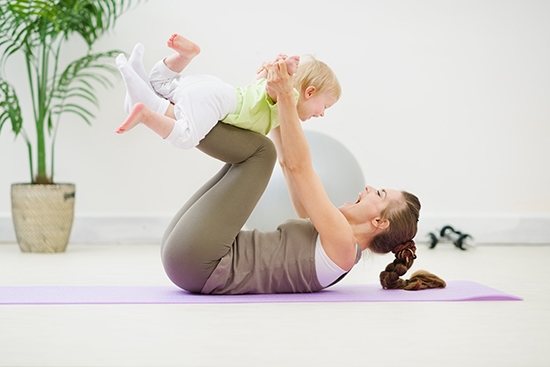
Many young mothers are concerned about the question of how soon after giving birth they can play sports, in particular, running. Alas, jogging will have to be postponed for at least six months, and with it:
- cycling;
- training on simulators;
- weightlifting;
- tennis;
- dance aerobics;
- Abs swing.
If you want more movement and active exercises, take up oriental dancing. They help restore flexibility and smooth movements, and also strengthen the abdominal and lower back muscles. Of course, they are of little use in the fight against extra pounds, but they will definitely help develop smooth movements and a beautiful, easy gait.
An alternative to running during guards
If for some reason a young mother cannot afford to run, you can replace the training with other exercises allowed under guard. It can be:
- Yoga - with the help of a set of exercises for beginners, you can stabilize blood pressure, protect the body from heart disease, and restore sleep. Yoga, unlike running, can be practiced within 40 days from the date of birth.
- Swimming helps you lose weight, strengthens and restores muscles. But a nursing mother will also be able to go to the pool for the first time three months after giving birth.
- Walking is the safest form of physical activity and is allowed for absolutely everyone. A nursing mother can walk with her baby or with a stroller.
- Pilates - actively works on the back muscles, posture, increases endurance, improves agility, flexibility and strength. But you can start classes only after four months from the birth of the baby.

If you follow simple rules, women who are breastfeeding can also run. After all, this is not only the simplest sport, but also a fairly effective method of losing weight. In addition to physical activity, running involves the development and strengthening of almost all body systems and health in general.


